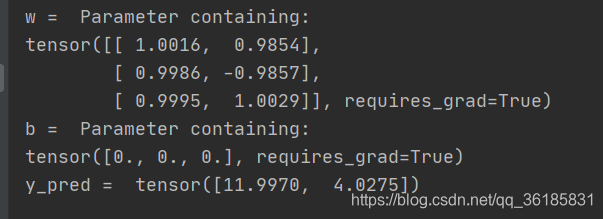PyTorch 自定义model简单示例
环境:python3.8
Pytorch介绍
Pytorch中文文档
import torch
import numpy as np
def test():
x_data = torch.Tensor([[2,2,1],[1,1,2],[-1,0,1],[-1,1,-1]])
y_data = torch.Tensor([[5,1],[4,2],[0,0],[-1,-3]])
# 对应关系为x [[1,1],
# [1,-1]
# [1,1]] = y
class MyModule(torch.nn.Module):
def __init__(self):
# 第一句话,调用父类的构造函数
super(MyModule, self).__init__()
# 对应x和y的特征数量
self.mylayer = MyLayer(len(x_data.data[0]),len(y_data.data[0]))
def forward(self, x):
x = self.mylayer(x)
return x
# y = w1*x1 + w2*x2 + w3*x3 + b
class MyLayer(torch.nn.Module):
def __init__(self, in_features, out_features, bias=True, weight=True):
# 和自定义模型一样,第一句话就是调用父类的构造函数
super(MyLayer, self).__init__()
self.in_features = in_features
self.out_features = out_features
# 由于weights是可以训练的,所以使用Parameter来定义
self.weight = torch.nn.Parameter(torch.Tensor(in_features, out_features))
self.bias = torch.nn.Parameter(torch.Tensor(in_features))
def forward(self, x):
y = torch.matmul(x, self.weight)
# 求当前均值
avg = 0
for i in self.bias.data:
avg += i
avg /= len(self.bias.data)
# 填充到所有
bias = torch.DoubleTensor(len(y.data),len(y.data[0])).fill_(avg)
y += bias
return y
model = MyModule()
# 均方误差损失
criterion = torch.nn.MSELoss(reduction='sum')
optimizer = torch.optim.SGD(model.parameters(), lr=0.001)
# 训练
print("loop -------------")
train_time = 1000
pre_loss = 0
for epoch in range(train_time):
y_pred = model(x_data)
# 误差越来越小
loss = criterion(y_pred, y_data)
if np.isinf(loss.item()):
print("loss is inf")
break
# 设置训练中断
if abs(pre_loss-loss) < 1e-5:
break
print(epoch, loss.item())
pre_loss = loss
optimizer.zero_grad()
loss.backward()
optimizer.step()
print('w = ', model.mylayer.weight)
print('b = ', model.mylayer.bias)
x_test = torch.Tensor([[3.0, 4.0, 5.0]])
y_test = model(x_test)
print('y_pred = ', y_test.data[0])
if __name__ == "__main__":
test()
结果图:

调整训练次数10000和中断条件1e-10后可以达到:






















 904
904











 被折叠的 条评论
为什么被折叠?
被折叠的 条评论
为什么被折叠?








